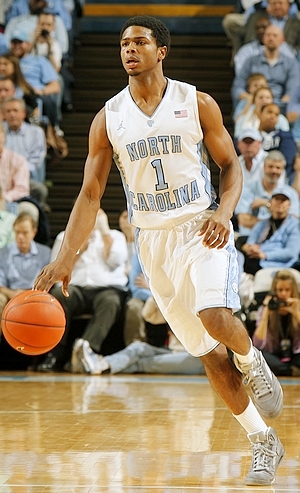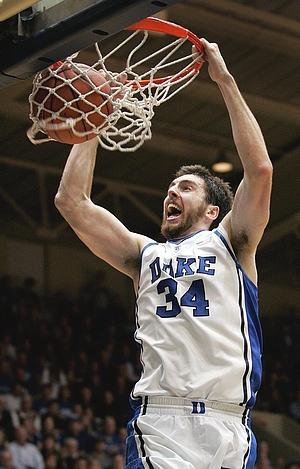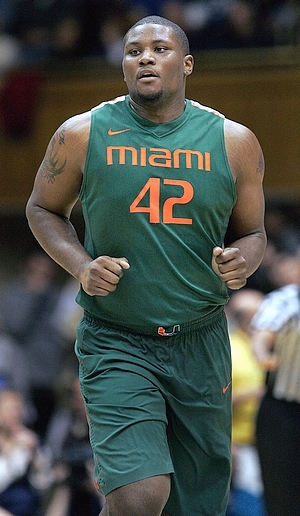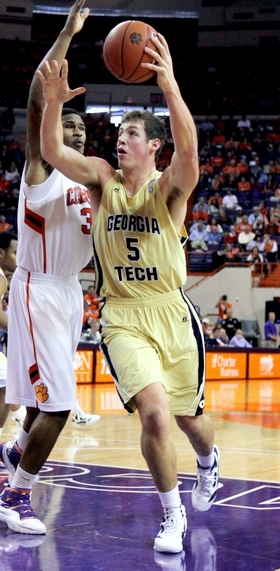Incoming freshmen have been excluded from these previews, as we'd like to wait and see what they have to offer on the NCAA level before we come to any long-term conclusions.
-Top 20 NBA Prospects in the Big Ten
-Top NBA Draft Prospects in the ACC, Part One
(#1) James McAdoo
-Top NBA Draft Prospects in the ACC, Part Two
(#2) C.J. Leslie (Video Scouting Report)
-Top NBA Draft Prospects in the ACC, Part Three
(#3) Mason Plumlee (Video Scouting Report)
-Top NBA Draft Prospects in the ACC, Part Four
(#4) Alex Len
(#5) Michael Snaer
-Top NBA Draft Prospects in the ACC, Part Five
(#6) Reggie Bullock
(#7) Lorenzo Brown
(#8) Richard Howell
(#9) P.J. Hairston
(#10) Travis Mckie
#11, Dexter Strickland, 6'3, Senior, PG/SG, North Carolina

Matt Williams
When we checked in on Dexter Strickland last fall, he was preparing for what promised to be a successful season for a deep and talented Tar Heels squad. Penciled in to a starting spot next to Kendall Marshall in Roy Williams' back court, Strickland was expected to be a secondary ball-handler, defensive stopper, and a constant threat in transition. He was able to provide as much through 19 games before suffering a season ending ACL tear in mid-January.
Heading back to Chapel Hill for his senior season, the team Strickland will be returning to will be a far different one than the one he left. With four of its five starters moving on to the NBA, North Carolina will be looking for one of its returning players to step up and emerge as a leader.
Whether Strickland is that player remains to be seen, but he'll play a key role for the Tar Heels yet again this season regardless, providing valuable minutes at both guard positions. The health of his knee will be a key factor in his ability to make an impact and how he's perceived by scouts by season's end. One of the fastest players in the country prior to his injury, Strickland's straight-line speed and lateral quickness were clear-cut NBA tools.
Strickland's speed is so important because it is essential to his offensive production, more than half of his possessions (51.4%) came on the fast break last season according to Synergy Sports Technology. That was the highest mark among all NCAA players with 70 or more transition possessions on the year by over 12%. The St. Patrick's high school product was a blur on the break prior to his injury, and had significantly improved his efficiency when pushing the ball as a junior, shooting 72.5% in transition thanks to improved touch and shot selection.
Another reason why Strickland's speed is so important to his stock is that fact that he's still developing the rest of his game offensively. His quick first step helps him create space in half court situations, and he showed improvement as a midrange shooter as junior, but he also removed the three-point shot from his arsenal (he took just one 3-point attempt all season), is not a prolific facilitator, and has lacked a prolific touch from the perimeter throughout his career. Tending to get out of control at times when attacking the rim, Strickland does not have the type of scoring ability that is common among NBA combo guard prospects, producing just 11.2 points per-40 last season, a similar mark to what he's posted his entire career.
He is, however, a very dynamic defensive player. Able to aggressively chase shooters off the line yet still recover quickly to deny dribble penetration, Strickland is one of the college game's best defensive guards thanks to his ability to apply pressure away from the basket and beat his man to spots on the floor.
If nothing else, Dexter Strickland is a very good role-player, who, if healthy, could provide value in the same areas he does in the college game at the next level a la Royal Ivey down the road. He showed some progress last season prior to his injury last season, but needs to continue developing his jump shot, expanding his scoring range, and becoming a more efficient drive and dish threat to maximize his stock this season. One of the most athletic seniors in the NCAA, it will be worth keeping an eye on how Strickland rebounds from his injury, and see whether he's able to expand his scoring repertoire on a very young and inexperienced UNC team.
#12, Ryan Kelly, 6'11, Power Forward, Senior, Duke

Kyle Nelson
Duke's impressive 2012 campaign fizzled down the stretch, culminating in a shocking NCAA Tournament upset at the hands of #15 seed Lehigh. Ryan Kelly was a key figure in both instances, providing a surprisingly versatile offensive spark before spraining his right foot against North Carolina and sitting out both the ACC and NCAA Tournaments. Before his injury, Kelly was finally starting to look like a McDonald's All-American-caliber player, as he was showing the potential to be a legitimate inside-outside threat with a penchant for hitting big shots in the clutch. Though he has emerged as a legitimate threat at the collegiate level, his NBA prospects remain uncertain.
At 6'11, Kelly has outstanding size for the power forward position with mobility and versatility to spare. He added nearly 30 pounds of muscle to his frame since entering Duke and, even at 234 pounds, looks like he can continue adding bulk to his frame. Maximizing his strength will be necessary as Kelly is a below average athlete with an average wingspan, as he lacks an ideal first step and the length or explosiveness to finish over his man around the basket.
On the offensive end, Kelly used nearly twice as many possessions as a junior and elevated his paltry sophomore production to an impressive 17.7 points per 40 minutes pace adjusted. He was an inconsistent scorer, however, logging 13 single-digit outings. He'll need to be more productive as a senior, but unlike in past seasons it was encouraging to see him employ his diverse skill set with increased comfort and settle into his role as a face-up power forward.
Kelly finds most of his offense, at this point, as a perimeter shooter. He lacks elevation on his jumper, but his consistent mechanics and a quick release, allow him to get his shot off without hesitation and with impressive accuracy. He was one of the top perimeter shooters in the NCAA last season, making an impressive 40% of his 4.7 attempts per 40 minutes pace adjusted. His shooting touch translates into an outstanding 81% shooting from the free throw line, as well.
Additionally, he has a diverse face-up game. Thanks to his above average ball-handling ability, he is able to operate very well out of the high post, taking his man off the dribble on his way to the basket. While he struggles to power the ball to the rim, he compensates with a finesse game including running hook shots, floaters, and layups. Furthermore, he has developed an intriguing mid-range arsenal based around his proficiency as a pull-up jump shooter.
While his lack of strength and explosiveness are glaring in the post, he actually displays very good instincts and developing footwork with his back to the basket. If he is able to carve out space on the blocks, then he shows a solid baseline spin move, at which point he can finish around the rim or launch a fade-away jumper. He is also a dual threat and proficient finisher out of the pick-and-roll, thanks to his mobility and shooting ability. He is a below-the-rim player, however, and so without getting stronger, it is difficult to see him contributing consistently in this capacity, let alone getting to the line 6.7 times per 40 minutes pace adjusted like he did last season, in the NBA.
Whether this offensive arsenal, in general, will work for him in the NBA remains to be seen, especially considering his mediocre 47% 2-point conversion rate and his tendency to get his shot blocked This, in particular, is an area of concern when projecting him to the next level: is he merely a shooting specialist or will he be able to find other ways to produce?
Concerns about his strength and athleticism are especially pronounced on the defensive end. Though Kelly is a very engaged defender with good instincts and awareness, his physical deficiencies stand out at this level and will most certainly be a problem at the next. In particular, his underwhelming lateral quickness and footspeed make him a liability away from the basket where he struggles to close out on perimeter shooters and is easily beaten off of the dribble by quicker players. At 6-11, he may be better off defending centers in the NBA, but does he have the strength to contain them in the post?
He is a below average rebounder for his size at 8.0 rebounds per 40 minutes pace adjusted, as well, which stacks up very poorly in comparison to power forwards in our database and certainly doesn't help his case when projecting him in an NBA rotation.
Kelly ultimately presents scouts with an interesting conundrum. Though he has an excellent feel for the game and NBA-caliber shooting ability out of spot-up, pick-and-pop, and isolation situations, his weaknesses likely relegate him to a very specific role at the next level. Therefore, any team that considers drafting him will have to be a perfect fit, able to mask his weaknesses and maximize his strengths. Despite his physical deficiencies, players with Ryan Kelly's skill-set are nevertheless very much in demand in today's NBA, which revolves heavily around spacing. It's not too difficult to see him landing on someone's roster when it's all said and done, but he will need to have a great senior year to ensure he gets drafted.
#13, Reggie Johnson, 6'9, Senior, C, Miami

Derek Bodner
After coming off of an encouraging sophomore campaign that saw significant improvement both in his physique and production, Reggie Johnson suffered a setback when he tore his meniscus during a pickup game in late June of 2011. The injury caused him to miss the first nine games of his junior season and, with the exception of one monster outing in an upset overtime win over Duke in Cameron Indoor, Johnson was never able to regain the same impact he had as a sophomore.
After spending six months rehabbing his injured knee, the work Johnson spent improving his physique did not go to waste. Johnson, who lost upwards of 40 pounds during his first two years in Miami, didn't appear to have added much, if any, weight to his frame while he was rehabbing. Unfortunately Johnson may have let him go once the season ended, as he tipped the scale at 329 pounds at the LeBron James Skills Academy in early July. He still has considerable work to do on his massive frame in order to maximize his potential, as this appears to be one of the biggest keys to carving out a consistent role in the NBA.
On the offensive end, Johnson remains largely an effective, albeit still not all that diversified, post-up player. His bread and butter is still a right handed hook shot, which he shows very good touch and solid range on. While he gets very little elevation, he does a very good job creating separation, and has little trouble getting the shot off with regularity. His overall diversity in the post still remains a little underwhelming, and he would be well served to develop his left hand should he look to make a living in the post at the next level.
One area of Johnson's post game that did see considerable improvement during his junior year was his recognition of double teams. Johnson saw double teams more frequently last year and he did a much better job of recognizing the double team early and locating the open man and preventing himself from getting trapped by defenders. His assist rate nearly doubled last season and he was able to post a near 1/1 assist to turnover ratio for the first time in his career, which is a good sign moving forward.
Johnson's other main source of offense is from the offensive glass. Johnson wasn't nearly as prolific as he was during his sophomore year, where he was one of the best offensive rebounders in the nation at 5.5 per-40, but his 3.9 offensive rebounds per 40 minutes pace adjusted still represents an above average mark. He does a good job of fighting for position and is able to use his bulk and soft hands to corral balls that are in his vicinity.
Johnson also shows some promise as a pick and roll threat, where he uses wide frame to present a clear target for passers as he dives to the hoop. Johnson has very soft hands and is able to catch most passes thrown his way. While Johnson isn't very explosive, he has good touch around the hoop and does a solid job creating separation with his off hand to get shots up. Still, his overall lack of explosion creates some concern about his ability to consistently get shots off against the taller defenders he'll see at the next level.
Johnson's main development in his offensive game has been from his jump shot, which he started to show some ability with during his junior season. At roughly 10% of his offense according to Synergy Sports Technology, that still represents a significant increase over the 3.8% jump shots took up during his sophomore season. Johnson overall shot 47.1% on jump shots, including 4-11 from three point range, which corresponds to a slight increase in his effectiveness at the free throw line, up to a solid 70.8%. His overall form and touch look solid and is something to keep an eye on during his senior season.
The defensive side of the ball still represents some troubles for Johnson due to his frame. He has good strength and long arms, but he's not able to change directions with his massive frame all that quickly, and his lack of elevation doesn't allow him to be much of a shot-blocking threat or weak side help defender. His defensive technique looked marginally improved, but he still finds himself off balance too often. His effort level is solid, but continuing to improve his conditioning would go a long way towards trying to project him as a defender at the next level.
Johnson made huge gains between his freshman and sophomore season, improving his conditioning and overall skill level significantly. His injury after his sophomore season set him back, but if he is able to get his conditioning back on track and continues to score efficiently both facing and with his back to the basket, it wouldn't be surprising at all to see him find his way onto an NBA roster.
#14, Daniel Miller, 6-11, Junior, Center, Georgia Tech

Jonathan Givony
After sitting out his first year as a redshirt, Daniel Miller started every game for Georgia Tech the past two seasons. Now a junior, Miller will attempt to make himself known as more than just the fourth best shot-blocker in the ACC.
Miller's biggest attraction as a NBA prospect, besides his defensive prowess, revolves around his excellent physical tools. Standing 6-11, with a good frame, a long wingspan, and very nice athleticism, he looks the part of a NBA center, and moves like one too-- running the floor well, and elevating off the ground quickly.
Unfortunately he still has a long ways to go to know how to take advantage of his strong physical tools, particularly on the offensive end, where he's very limited. Miller plays a fairly small role on a Georgia Tech team that struggled badly to put the ball in the basket last season. His skill-level is not very high, as he's the type of player who needs to have his offense created for him exclusively, and preferably around the basket. The only problem is his team suffered from some of the worst guard play in the ACC last year, not having anyone on their roster that can create offense efficiently on a consistent basis.
Miller is a very solid finisher, converting an impressive 67% of his field goal attempts around the basket last season. He has good hands, solid touch, and the ability to play above the rim with ease, sometimes elevating and finishing from impressive distances.
He also shows some flashes of being able to knock down a mid-range jump-shot, even if his shot-selection leaves something to be desired. He hit 76% of his free throws last season, showing solid potential in this area.
Desperate for offense, Georgia Tech tends to throw him the ball into the paint relatively often, but doesn't find much success doing so. Miller doesn't have the lower body strength or know-how of how to establish favorable post position. When he does catch the ball on the block, he shows poor footwork, limited coordination and no left hand, only converting on 38% of his field goal attempts in these situations, and very rarely drawing fouls.
While it's unlikely he'll ever develop into a polished low-post player, Miller's outlook defensively looks far more promising. As mentioned, he ranked as one of the best shot-blockers in the ACC last year, thanks to his terrific combination of size, length, mobility and instincts. He moves his feet very well on the perimeter for a player his size, being capable of stepping out and hedging screens and then quickly recovering. Even when beat by an opposing ball-handler, he's often mobile enough to recover and still make a play at the rim, using his length very well to alter shots around the basket.
While he's a capable help-side defender and gets a decent amount of blocks rotating to help his teammates out, he's also a very solid man to man defender, showing the size and strength to hold his ground in the post against most of the back to the basket targets he faces in the ACC. He's very patient here, rarely biting on pump-fakes, and committing an incredibly low number of fouls.
One area where Miller will have to improve in order to solidify his standing as a NBA prospect is on the glass, on both ends of the floor. He grabbed just 9.1 rebounds per-40 minutes pace adjusted last season, which is fairly poor. Considering the limitations he shows offensively, NBA teams will want to know that he can be counted on to at least contribute at an above average rate here.
Surely not a glamorous prospect by any stretch of the imagination, Miller's size, mobility, shot-blocking prowess and finishing ability give him at least a fighting chance of carving out a role at the NBA level. Players with his physical tools are not easy to come by, and if he can continue to improve on his weaknesses over the course of his final two seasons at Georgia Tech, he could certainly emerge as a prospect NBA teams will want to follow.
#15, Durand Scott, 6-3, PG/SG, Senior, Miami (FL)

Joe Treutlein
Heading into his senior season, Durand Scott has had a very flat trajectory in his development in his three years at Miami, posting very similar stat lines every season. On the court, Scott also remains largely the same player as the one who stepped foot on campus as a freshman, and will likely need to show some growth this year to put himself more firmly into NBA discussions.
On the offensive end, Scott's dribble-drive game remains his hallmark, and he possesses the same strengths as the last time we profiled him. Showing a very strong handle with either hand and nice creativity, Scott has no problem breaking down the defense in a variety of situations, being equally effective in transition, isolations, and pick-and-rolls.
At the basket, Scott is a good but not great finisher, using a solid combination of power and finesse depending on the situation, while probably being most impressive with his ability to competently score with either hand around the rim. He does show some issues scoring consistently when facing frontcourt weak side help, however, which could only become more of an issue at the next level. For this reason as much as any other, it's likely critical Scott improve in another area of his game to diversify what he brings to the table.
Scott's shooting is the most obvious issue he could improve to get him more firmly on the radar, but he hasn't shown much progress thus far. Scott hasn't averaged more than 2.0 three-point attempts per game in any of his three seasons, and despite an impressive bump in his shooting to 39.1% as a sophomore, he fell back to earth as a junior when he shot 31.1%. Scott would help himself greatly to see a strong improvement in both his attempts and efficiency this season, but at this late stage in his development it might not be that likely.
The other area Scott can help himself with is developing into more of a traditional point guard, but this is another area where he hasn't seen much growth since his freshman season. Despite his strong ability to break a defense down and the flashes of nice drive-and-dish passes he makes, he doesn't really seem to have a true point guard's feel for managing an offense and balancing his own scoring and passing. Scott's 4.9 assists per 40 minutes pace adjusted as a freshman were actually the best of his career, as he posted just 3.7 by the same metric as a junior.
Defensively, Scott continues to be a strong asset to his team with his solid combination of size, athletic ability, fundamentals, and tenacity, making him effective in both isolations and pick-and-rolls. He can show troubles consistently staying in front of some of the quicker lead guards in the NCAA, however, and may be a bit between positions on the defensive end projecting to the NBA, being small for a shooting guard and not quite quick enough for a point.
Looking forward, Scott has had a solid college career and brings a well-defined set of skills to the table, but doesn't really overwhelm in any one area and may be caught between positions on both ends of the floor. His lack of growth in every facet of his game over his three seasons isn't encouraging, but he still has time to take his game to the next level as a senior.
With his solid size and ability to create his own shot--and the premium that is placed on this skill--Scott will have a plethora of opportunities to play professionally and continue to improve his game, which could lead to a shot in the NBA down the road if he isn't able to get one immediately following his collegiate career.




































Comments